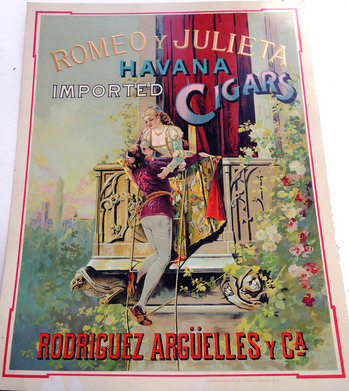The French expatriot artist Frédéric Mialhe (1810-1881) lived and worked in Cuba from 1838 to 1854. He was brought there to be a landscape painter for the newly established lithographic press of François Cosnier and Alexandre Moreau de Jonnes under the sponsorship of the Royal Patriotic and Economic Society of Cuba. With three presses, five operators, and one master painter, it was “one of the most outstanding enterprises of its kind ever attempted in Cuba” (Cueto).
It wasn’t until 1861 that chromolithograph came to Cuba but once the technicians were trained, production was enormous. A particular relationship between the tobacco industry and the chromolithographic printers developed. Everything from the largest posters to the smallest cigar bans were printed and embossed in elaborate multicolor designs.
One example in the graphic arts collection is a vintage poster for the Romeo y Julieta Cigars. The company was established in 1875 and this print is probably from the early in the 1900s, based on the brand. For more information on Cuban lithography, see: Emilio Cueto, Mialhe’s Colonial Cuba: the Prints that Shaped the World’s View of Cuba (Miami: Historical Association of Southern Florida, c1994). Firestone Library (F) NE2325.5.M5 A4 1994
